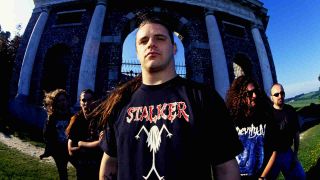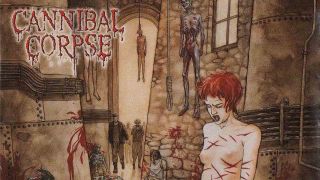Metal moves in cycles, just like everything else. If you don’t believe us, just listen to George ‘Corpsegrinder’ Fisher, the frontman of the goriest death metal band there’s ever been.
“In 1997,” says George, “black metal had risen and everyone had a death metal band! Some of them weren’t so good...”
Cannibal Corpse were one of the most successful death metal acts in the world for a couple of years at this point, despite – or perhaps because of – the horrifically graphic nature of their songs. Their fifth album, Vile, appeared in 1996 and was the first to feature George, who had left his old band Monstrosity to replace CC’s first singer, Chris Barnes. Making history by landing on the arse-end of America’s Billboard chart, Vile made it clear that the new lineup meant business.
Many metalheads were fixated on the new wave of black metal manating from Scandinavia, the UK and the US. Just as grunge had killed glam back in 1991, a new movement of corpsepainted bands was making the death metal scene look tedious, or worse, obsolete. Only the best would survive.
- The best Metallica merch 2020: amazing gifts for the Metallica fan in your life
- Less noise, more rock with the best budget noise cancelling headphones
- Best music streaming services: how do Spotify, TIDAL, Apple Music and others compare?
- Loudest Bluetooth speakers: the best speakers for maximum noise
CC’s solution was to record an album that would take the legacy of Vile, make it darker and more atmospheric and prove that death metal still had balls. It helped that the band had finally come into their own as musicians.
“By this point, we’d got a grip of our instruments and we’d hit our stride,” bassist Alex Webster recalls. “Every album sounded tight, and by the time George joined the band we were tuning lower too.”
Required to play faster, deeper and tighter than ever before, CC hit a stroke of luck when one of their guitarists, Rob Barrett, departed after Vile and was replaced by Pat O’Brien, a supremely technical player – just what they needed in order to re-stake their claim.
“It’s a crazy coincidence,” recalls George, “because Pat added technique to the band that we didn’t have before. We’re not super-technical, but we were definitely heading in that direction.”
“When Rob left, we’d written about three songs for the new album,” Alex adds. “We carried on writing and took a couple of months before we chose another guitar player. This was one change that we didn’t have to make in a hurry, for once! He left around February 1997, and we didn’t do any recording until October that year.”

- Cannibal Corpse: The Story Behind Hammer Smashed Face
- 10 times metal hit the headlines for the wrong reasons
Nowadays, when a band need a new guitar player they just send out a few emails, Tweet a post and the applications roll in, but back then it was entirely different.
“None of us had computers,” laughs Alex. “1997 was still way before the internet age. None of us had computers until about five years ago! We didn’t have cellphones, so there wasn’t really a way to get the word out – it just spread in the old-school way of people hearing about it from this person or that person.”
From the off, Pat – then with melodic metallers Nevermore, a world away from the blood-freezing violence of Cannibal Corpse – was the obvious contender to take over from Rob.
“I’d met Pat before he came down to audition, because we hung out when I was still in Monstrosity,” remembers George. “He was cool. He keeps to himself.”
In fact, Pat came with many approvals. “Our soundman said that he knew him and that we should meet him because he was cool and into death metal,” says Alex. “Also Steve Tucker, who was in Morbid Angel at the time, had played with Pat and recommended him, so there’s another person who was pushing Pat in our direction, and we ended up reaching out to him. Once he came down to Florida, it was clear that he was going to be the best guy.”
Alex adds that Pat is naturally reserved. “I’d probably have been disconcerted by his seeming lack of enthusiasm, if I hadn’t been warned by a few people that that’s just how Pat is – he’s not going to be jumping around getting excited about things!”
Despite his reserved outward appearance, Pat was keen to get to work, and came to the first sessions for what would become Gallery Of Suicide with a fully formed song, Stabbed In The Throat. The track meshed instantly with those contributed by the rest of the band, such as Blood Drenched Execution, Dismembered And Molested and Every Bone Broken, making Gallery… an hour-long symphony of cruelty. So where did Cannibal get their ideas for these frankly terrifying songs?
“Just by watching the news you can find plenty of inspiration – and then on top of that you’ve got all the great horror movies and novels out there,” Alex explains. “There’s an unlimited amount of bad things happening in the world, real and imagined, so it’s not too hard for us to come up with stuff.”
Once the songs were written, Cannibal moved down to the famous Morrisound studio in Tampa. George remembers this time with a chuckle, saying, “I lived in a house with Paul [Mazurkiewicz, drummer] and another friend of mine, and it was a crazy time. We were slobs and just partying!”
- The life and death of Chuck Schuldiner: the godfather of extremity
- The top 10 most underrated death metal albums
When recording time came around, however, the fun and games stopped: Cannibal were there to demonstrate the fearsome skills of their new lineup, and went into the studio sessions with all weapons drawn. Producer Jim Morris had a shock coming to him, recalls George, whose vocal delivery was astounding.
“Jim did a great job. I talked with him about some of the lyrics and he was dying with laughter! One time, he was laughing while I was recording – so I said, ‘Dude, did I mess up?’ and he said, ‘No, no – how are you doing this? What the fuck are you doing? These lyrics are out of control…’ There’s some fast shit on there!”
The songs were laid down one by one, with all-time classics such as I Will Kill You and Centuries Of Torment joining Cannibal standards like 1993’s Hammer Smashed Face. Several of the songs, notably the title track and From Skin To Liquid, which deals with the laugh-a-minute subject of human decomposition, contained atmospheric sections that contrasted with the warp-speed blast- and-roar that fans had come to expect.
“Gallery… is one of the most experimental albums we’ve done,” George explains. “The title track itself is a little bit different: some parts are almost black metal-ish with blastbeats. It wasn’t on purpose – it just turned out that way.”
Although Cannibal Corpse hadn’t intended their album to appeal to black metal fans, that sector of the head-banging community heard the darker, more thoughtful side of Gallery… and liked it. In addition, both death and black metal bands were seen for the first time on the same bills at about this time.
“We played on some smart tour packages, like with Marduk and Dark Funeral,” says Alex. “Black and death metal come from the exact same roots, from mid-80s stuff like Sodom, Kreator, Celtic Frost and Possessed, so there was no reason why they couldn’t tour together, and that worked out really well.”
The final step was the artwork. As with most CC covers, Gallery Of Suicide boasted a highly explicit cover, designed by the band’s long-time sleeve artist Vincent Locke. It depicts a grim dungeon in which a group of characters are hanging, shooting and disembowelling themselves.

“People go in there and commit suicide, and if you’re unfortunate enough to be curious to see what this gallery is about, or crazy enough, you can go inside,” George explains.
A toned-down cover with less gore was also commissioned from Vincent for the benefit of high-street stores.
“I love the censored cover as much as the uncensored one,” Alex claims. “It’s really dark and eerie-looking.” After years of commissioning covers that are a combination of horror and high art, Alex is relaxed about the subject of censorship.
“Some day, every major world leader is going to have grown up with heavy metal or hip-hop, and it’s not gonna pack the same kind of fear for them, and so eventually the whole censorship problem will extinguish itself. But for the time being, it’s still around.”
After all this time, how does Gallery Of Suicide sound to the band?
“It’s one of the darkest albums we ever did: there’s dark melodies, dark lyrics,” says Alex. “I mean, all our albums are dark, with songs about murder and so on, but there’s something extra-dark about that one!”
And if you’re wondering whether Cannibal Corpse managed to beat the decline of death metal to reclaim their position at the top of America’s extreme metal scene, the answer is obvious. Looking back, it seems that the death metal movement needed to rid itself of a few lesser bands to keep moving forward.
“A genre of music can only be a brand new thing for a couple of years,” says Alex, “and then it becomes established, which is what had happened with death metal by that point. We were lucky enough to have fans who stayed with us, so with the whole dip in death metal, we didn’t see it the same way that other bands did.”
“Death metal never went anywhere,” George concludes, with immense satisfaction. “Deicide, Immolation, Mortician, Morbid Angel and us – we were all still out there touring. We knew the fans still cared.”
We still do, George, we still do.
Published in Metal Hammer #198

